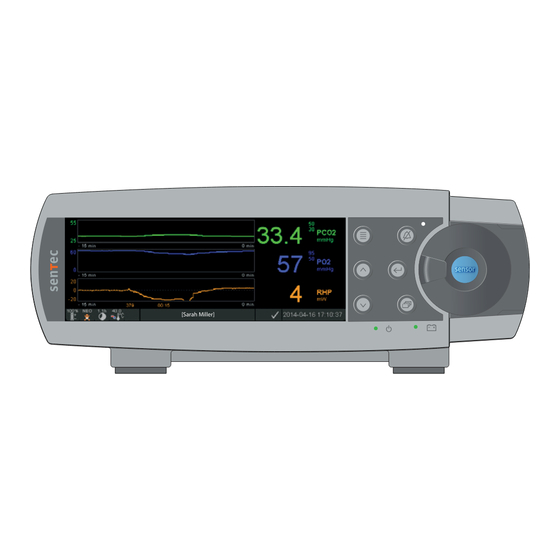Summarization of Contents
Intended Use, Principles of Operation and Limitations
Intended Use of the SenTec Digital Monitoring System (SDMS)
Defines the system's intended applications and patient populations.
Transcutaneous PCO₂ and PO₂
Explains the principles behind measuring CO₂ and O₂ through the skin.
Limitations of tcPCO₂ and tcPO₂
Details factors that can affect transcutaneous gas measurement accuracy.
Pulse Oximetry
Describes the principles of measuring oxygen saturation and pulse rate.
Limitations of Pulse Oximetry
Lists situations that may affect pulse oximetry readings.
SenTec TC Sensors
Overview of the technology and features of the SenTec TC Sensors.
The SenTec Digital Monitoring System (SDMS)
SenTec Digital Monitor (SDM)
Components and configurations of the main monitoring unit.
SenTec TC Sensors (V-Sign™™ Sensor 2 or OxiVenT™™ Sensor)
Types and capabilities of the transcutaneous sensors.
Digital Sensor Adapter Cable
Cable used to connect SenTec TC Sensors to the SDM.
Ear Clip and Multi-Site Attachment Rings
Accessories for attaching sensors to patients.
Staysite™™ Adhesive
Adhesive for improving sensor attachment security.
Contact Gel
Liquid used for sensor application to the skin.
Service Gas
Gas used for calibration of SenTec TC Sensors.
Membrane Changer
Tool for replacing sensor membranes.
V-STATSM Software
PC software for data download, analysis, and monitoring.
SDMS Documentation
Manuals and guides related to the SDMS.
Setting up the SDMS
Connect SDM to AC Power
Procedure for connecting the device to mains power.
Battery Operation of the SDM
Information on using the device with its internal battery.
Turning on the SDM
Steps to power on the SenTec Digital Monitor.
Installation of the Gas Bottle (Service Gas-0812)
Connect Digital Sensor Adapter Cable
Instructions for connecting the sensor adapter cable to the SDM.
Connection of a SenTec TC Sensor
Connecting Sensor to Digital Sensor Adapter Cable
Steps to physically connect the sensor to the adapter cable.
Inserting Sensor into Docking Station
Procedure for placing the sensor in the docking station for calibration.
Sensor Check, Calibration, Storage, and Membrane Change
Checking a SenTec TC Sensor
How to inspect the sensor for damage and proper function.
Sensor Calibration and Storage
Steps to Calibrate the Sensor
Detailed procedure for calibrating the SenTec TC Sensor using the docking station.
Changing the Sensor Membrane
When to Change the Sensor Membrane
Criteria and process for replacing the sensor's membrane.
Inserting Sensor into Membrane Changer
Membrane Change Procedure Steps
Step-by-step guide for using the membrane changer tool.
Patient Monitoring with the SDMS
Selection of Patient Type, Site, and Accessory
Guidance on choosing patient type, measurement site, and attachment method.
Check SDM Settings and System Readiness
Verifying 'Ready for use'/'Calibration' Screen
How to confirm the SDM is ready for patient monitoring.
Sensor Application Using a Multi-Site Attachment Ring/Easy
Attaching the Ring and Sensor to the Patient
Detailed steps for applying the sensor using the MAR/e.
Sensor Application Using an Ear Clip
Attaching the Ear Clip and Sensor to the Earlobe
Detailed steps for applying the sensor using the ear clip.
Patient Monitoring
Sensor-On-Patient Detection
How the SDM detects correct sensor placement on the patient.
TC-Stabilization after Sensor Application or 'TC-Artifacts'
Understanding TC Stabilization and Artifacts
Explains how readings stabilize and what causes artifacts.
Preconfigured Measurement Screens
Overview of Display Options
Describes the different measurement screen layouts available.
Quality Indicators for Measurement Parameters
Parameter Quality Status Definitions
Explains the meaning of 'Valid', 'Questionable', 'Unstable', and 'Invalid' indicators.
Ax-Values and Baseline Values
Understanding Ax-Values and Baseline Values
How to interpret trends and differences from baseline values.
Operator Events
Recording and Visualizing Operator Events
How to log and view events during monitoring.
RHP Online Trends/Setting RHP Reference
Understanding and Setting RHP Reference
Explains Relative Heating Power trends and reference setting.
V-Check™™ Mode
Using V-Check™™ Mode for Spot Checks
Guide to performing quick ventilation spot checks.
PCO₂ In-Vivo Correction
Performing In-Vivo PCO₂ Correction
Procedure for adjusting PCO₂ readings based on blood gas analysis.
Patient Data Management
Storing and Transferring Patient Data
How the SDM manages and outputs patient data.
Remaining Monitoring Time / Site Time Elapsed Alarm
Understanding Monitoring Time Alarms
Explains alarms related to sensor application duration.
Sensor Removal with Multi-Site Attachment Ring/Easy
Removing Sensor for Subsequent Reattachment
Steps for removing and potentially reattaching the sensor.
Sensor Removal with Ear Clip
Removing Sensor for Subsequent Reattachment to Earlobe
Steps for removing the sensor from the ear clip.
Controls, Indicators and Alarms
Front Panel Controls (Buttons)
Details on the function of each button on the SDM.
LED Indicators
Description of LED Indicators
Explains the meaning of the various LED status lights.
Auditory Indicators/Signals
Description of Auditory Signals
Explains the different sounds the SDM makes.
Alarms
Understanding Alarm Priorities and Settings
Information on alarm types, priorities, and setting limits.
Visual Alarm Signals
Visual Indication of Alarm Status
How alarm conditions are visually represented on the display.
Auditory Alarm Signals
Auditory Indication of Alarm Status
How alarm conditions are signaled audibly.
Status Bar with Status Icons and Status Messages
Interpreting Status Bar Information
Guide to understanding the icons and messages in the status bar.
Alarm Status Icon and Barometer Information
Understanding Alarm and Barometer Icons
Explains the alarm status icon and barometer readings.
Maintenance of the SDMS
Routine Maintenance Checks
Regular checks and cleaning procedures for the SDM.
Service
Recommended Service and Repair Procedures
Guidelines for professional maintenance and repair.
Specifications of tcPCO₂, tcPO₂, and Pulse Oximetry
tcPCO₂ and tcPO₂ Specifications
Technical specifications for transcutaneous gas measurements.
Specifications of Pulse Oximetry
Oxygen Saturation (SpO₂) Specifications
Technical specifications for SpO₂ measurement.
Pulse Rate (PR) Specifications
Technical specifications for pulse rate measurement.
Glossary of Symbols
Symbols on Device and Packaging
Explanation of symbols used on the device and its packaging.











Need help?
Do you have a question about the SpO2 and is the answer not in the manual?
Questions and answers